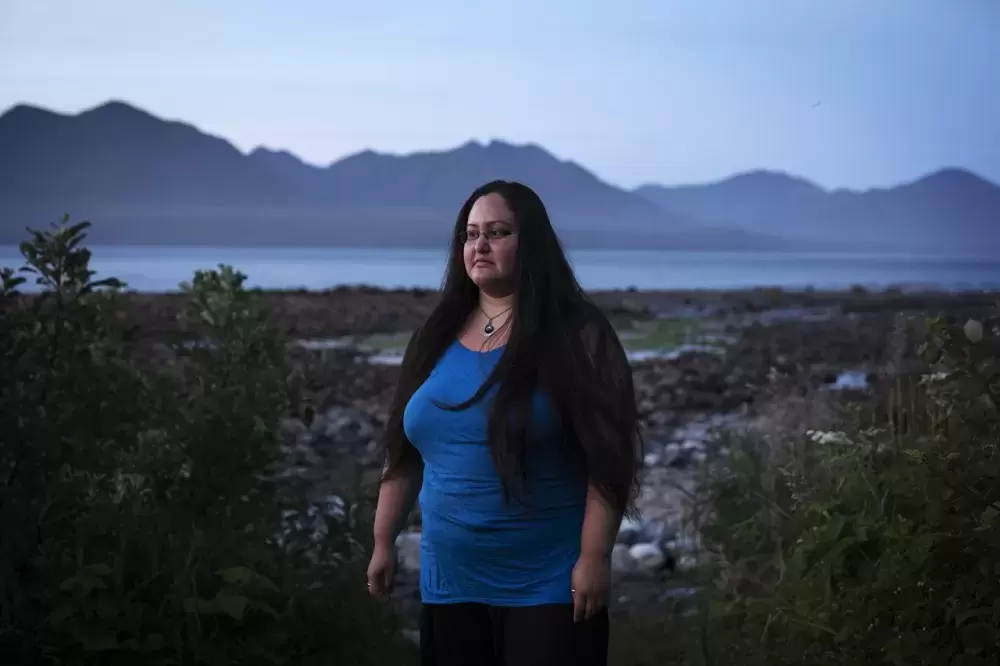When Dianne Ignace moved to the Heshquiat Peninsula in 1975, she remembered looking towards the skyline during herring season. A thick cloud of seagulls had moved in, blocking the view of the mountain range across the harbour. They flocked by the thousands, dodging eagles, ducks and sea lions that gathered to feed on the herring.
There used to be gill-netters and big seine boats all the way up to Prince Rupert, Ignace recalled. “Herring season was crazy in the 70s. It was nuts.”
Things have dramatically changed since then.
“This place is sort of sterile now,” she said.
In those days, Ignace and her late-husband, Dave, raised their four children by only spending $300 a month on groceries. Aside from dry goods, such as rice and flour, everything else came from the land, the sky or the ocean.
“The whole sandbar used to be covered in clams,” she said.
As a family, they would take a 100-pound sack down to the beach and fill it in 20 minutes. The hard part was getting it back to the house, where they would feast on clam jacks, Ignace recounted.
“That clam bar has been supporting the Hesquiahts living here for 6,000 years,” she said.
But in more recent years, they have disappeared.
“There are no more clams,” she said. “The clams are all gone.”
In 1991, biologist and whale researcher Jim Darling spent six weeks camping out at the Ignace’s. In partnership with Sam Mickey, from Hesquiaht First Nation, they looked at 76 different food resources in 32 locations within the peninsula.
The study compiled material provided by Hesquiaht elders who described specific locations in their territory where food resources were traditionally found. The researchers sought everything from sea urchins to wild berries.
“In most cases, we found the resource that was talked about,” said Darling.
Most, except for sea otters.
Before their extinction in the early 20th century, the last verified sea otter on the B.C. coast was shot near Kyuquot in 1929, according to the Department of Fisheries and Oceans Canada (DFO).
The species existed all along Vancouver Island for eons. But when the sea otter fur trade began in the 1700s and the first pelts were traded to Captain James Cook from the village at Nootka Sound, their eradication began.
“By about 1850, sea otters were driven to very low levels,” said Linda Nichol, DFO’s lead sea otter researcher. “They were almost what we would call ecologically extinct. So at that point you have a system where the otters are in relatively low numbers, so they’re not having the same ecosystem role that they have evolved to occupy.”
In response, DFO translocated 89 sea otters from Amchitka and Prince William Sound, Alaska, to Checleset Bay on the west coast of Vancouver Island between 1969 and 1972.
“It was an era of desire to re-establish things within the ecosystem,” said Nichol.
According to the DFO, they have repopulated in 25 to 33 per cent of their historic range and are steadily growing in numbers.
When sea otters first arrive to an area, they eat a few of the most abundant organisms, described Nichol.
“But over time, as that particular species declines in abundance, they begin to diversify their diet,” she said.
Ignace attributes the sea otters for wiping out the sea urchins and the clam bar.
“They cleaned out the harbour of a lot of resources,” she said. “I’ve been here for 45 years. I’ve seen a whole decline in the resources like you’ve never seen before.”
When the species was re-introduced, there was a flip in the ecosystem.
“The system now is not the system that was there before the otters arrived,” said Nichol. “Clam densities are probably lower and clam sizes are probably smaller. From a human harvesting perspective, there’s definitely an impact.”
Despite the shift in the ecosystem, Nichol said that species don’t overpopulate areas.
“Their population growth is regulated by food availability,” she said. “When the population approaches the carrying capacity of an area, and for these animals it’s food availability, the survival of the pups goes down.”
Ignace calls it DFO “propaganda”.
“They do travel and they do devastate everything and then when place is right naked, they move on,” she said of the species that eats 30 per cent of its body weight each day.
First Nations along the coast used to hunt sea otters for their fur. It was used to decorate the collars of capes for their chiefs.
It is now illegal to hunt the animal after it was listed as “threatened” under the Species at Risk Act.
To monitor the changing landscape, Ignace’s daughter, Korianne, began video recording the beaches at low tide in 2011. She has been building an archive of footage to document the decline of sea urchins, the loss of barnacles attached to their sea wall and the disappearance of seaweed that used to collect on the rocks at their shoreline.
“Why live here if you don’t know what’s happening or why it’s here?” said Ignace. “You have to become a part of where you live.”
While the sea otters are not solely responsible for altering the nearshore ecosystem in the Hesquiat Harbour, they have played contributing factor.
The change in available resources has forced Ignace to become more dependent on the grocery stores in Tofino. She travels into town with her son, Jeffery, at least once a month to stock up, unable to rely on the ocean like she once did.
“We’re still documenting this stuff,” she said. “This is a lifelong project, man.”







